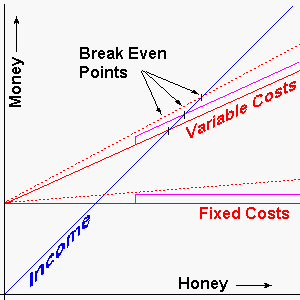|
|
|
|---|
|
|
Book Keeping For Beekeepers |
|---|
Profit and loss
- Annual Expenditure (Fixed Costs)
- Apiary rent
- Rent of premises (if rented)
- Business and water rates, Accountant's fees
- Insurance (there may also be a variable element to this due to colony numbers)
- Loss of interest on own capital
- Interest paid on borrowed capital
- Bank charges
- Depreciation of Assets
- Vehicles (trucks and fork lifts)
- Premises (if owned)
- Bees in hives, Hives and frames
- Extractors and other processing equipment
- Clothing, Office Equipment
- Replacement of worn out equipment
- Annual Expenditure (Variable Costs)
- Labour Costs
- Queens (if purchased)(or the materials and labour if "home grown")
- Feed and Chemical Treatments
- Electricity, Gas, Heating Oil, Petrol and Oil
- Water Bills (extra to water rates)
- Vehicle maintenance, Building maintenance
- Carriage
- Packing materials, including Jars, Lids and Labels
- Ingredients for Soap, Ointments, Creams, Leather dressing and any other associated products
- Marketing, Advertising, Bookkeeping, Office Administration, Telephone and Internet
- Annual Income
- Honey Sales at Retail prices
- Honey Sales at Wholesale prices
- Sales of Other hive products (Wax and Propolis)
- Sales of Soap, Ointments, Creams, Leather dressing and any other associated products
- Sales of Queen bees and Nucs
- Pollination Contracts
- Resale of equipment bought in bulk (to other beekeepers)

|
Income and expenditure are plotted against honey production.
This graph can be used either to establish the profitability of an enterprise or conversely it can be used to find production targets for a given reward. The dotted red cost lines refer to the situation where some fixed costs may vary with colony numbers in a linear fashion. The Pink lines represent jumps in fixed costs like the need for a second or larger vehicle. In many beekeeping enterprises no "profit" is made until after the first 8 or 10 hours have been put in during the day. The "Break Even Point" may not occur until the last month of the year, which may incur extra interest on working capital borrowed. In a "bad" year the break even point may not be reached, then some serious appraisal of what went wrong is then needed, but it is not enough to know what went wrong, you need to correct the problem. |
|---|
|
Beekeeping has some peculiarities in this respect, bees may be subject
to disease and/or vandalism.
Combs can only be considered to have the value of the wax that could be rendered from them. (If in storage such comb can only be counted after it is rendered into wax blocks in case it is destroyed by wax moth.) Gloves wear out after one season's use and must be considered as consumables rather than clothing. |
|
|---|
Written... Spring 2001, Revised... 17 October 2001, New Domain... 24 July 2004, |
|
|
|---|